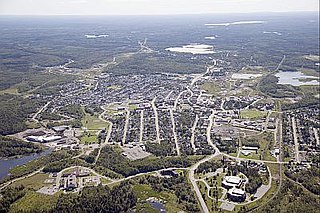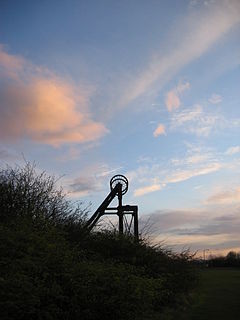
Launceston is a city in the north of Tasmania, Australia, at the junction of the North Esk and South Esk rivers where they become the Tamar River (kanamaluka). With a population of 87,328, Launceston is the second most populous city in Tasmania after the state capital, Hobart, and the twelfth-largest non-capital city in Australia.

Kirkland Lake is a town and municipality in Timiskaming District in Northeastern Ontario, Canada. The 2016 population, according to Statistics Canada, was 7,981.

Beaconsfield is a former gold mining town near the Tamar River, in the north-east of Tasmania, Australia. It lies 40 kilometres north of Launceston on the West Tamar Highway. It is part of the Municipality of West Tamar.

Beauty Point is a town by the Tamar River, in the north-east of Tasmania, Australia. It lies 45 km north of Launceston, on the West Tamar Highway and at the 2016 census, had a population of 1,222. It is part of the Municipality of West Tamar Council.

Keweenaw National Historical Park is a unit of the U.S. National Park Service. Established in 1992, the park celebrates the life and history of the Keweenaw Peninsula in the Upper Peninsula of the U.S. state of Michigan. As of 2009, it is a partly privatized park made up of two primary units, the Calumet Unit and the Quincy Unit, and 21 cooperating "Heritage Sites" located on federal, state, and privately owned land in and around the Keweenaw Peninsula. The National Park Service owns approximately 1,700 acres (690 ha) in the Calumet and Quincy Units. Units are located in Baraga, Houghton, Keweenaw, and Ontonagon counties.

Calstock is a civil parish and a large village in south east Cornwall, England, United Kingdom, on the border with Devon. The village is situated on the River Tamar 6 miles (9.7 km) south west of Tavistock and 10 miles (16 km) north of Plymouth.

Geevor Tin Mine, formerly North Levant Mine is a tin mine in the far west of Cornwall, United Kingdom, between the villages of Pendeen and Trewellard. It was operational between 1911 and 1990 during which time it produced about 50,000 tons of black tin. It is now a museum and heritage centre left as a living history of a working tin mine. The museum is an Anchor Point of ERIH, The European Route of Industrial Heritage. Since 2006, the mine has been part of the UNESCO World Heritage Site Cornwall and West Devon Mining Landscape.

The Beaconsfield gold mine collapsed on 25 April 2006 in Beaconsfield, Tasmania, Australia. Of the seventeen people who were in the mine at the time, fourteen escaped immediately following the collapse, one was killed and the remaining two were found alive on the sixth day by miners Pat Ball and Steve Saltmarsh. These two miners were rescued on 9 May 2006, two weeks after being trapped nearly a kilometre below the surface.

Morwellham Quay is an historic river port in Devon, England that developed to support the local mines. The port had its peak in the Victorian era and is now run as a tourist attraction and museum. It is the terminus of the Tavistock Canal, and has its own copper mine.

*This article is about a region in Australia. For coast of County Waterford, Ireland, see Copper Coast (Ireland).

Hillgrove is a Northern Tablelands village with population of about 95. The village is located approximately 30 km east of Armidale and is 5 kilometres south of the Waterfall Way. Hillgrove is part of the Armidale Regional Council local government area and is in Sandon County. This historic goldmining town is situated at elevation of 1,000 metres on a granite plateau above Bakers Creek and near the Oxley Wild Rivers National Park.

Prestongrange Museum is an industrial heritage museum at Prestongrange between Musselburgh and Prestonpans on the B1348 on the East Lothian coast, Scotland. Founded as the original site of the National Mining Museum, its operation reverted to East Lothian Council Museum Service in 1992.

The Autrey Mill Nature Preserve & Heritage Center is located in Johns Creek, Georgia, U.S.A.

Queenton is a suburb of Charters Towers in the Charters Towers Region, Queensland, Australia.

The Allihies Copper Mine Museum (ACMM) is a museum dedicated to the history of copper mining in the Allihies area in County Cork. It is situated on the Wild Atlantic Way.

Grubb's Tramway was a partially completed, private logging tram line in Tasmania from the junction of the Launceston-George Town Road at the Tamar River near Mowbray to a saw mill at Pipers River.

Willian Dawson Grubb was a Tasmanian politician, lawyer, and investor in timber and mining ventures.
The Tamar Hematite Iron Company (THIC) was an iron mining and smelting company that operated from April 1874 to December 1877, in the area close to the location of the modern-day township of Beaconsfield,Tasmania, Australia.

The Ilfracombe Iron Company (I.I.C.) was an iron mining and smelting company that operated in Northern Tasmania in 1873 and 1874.















